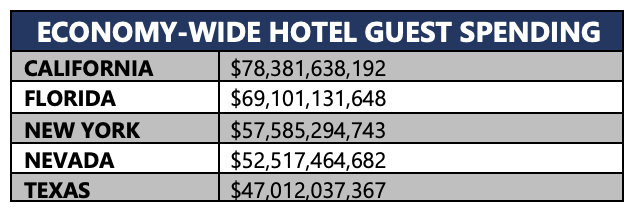New research highlights hotel industry’s significant economic impact
American hotels support 8.3 million American jobs, which is equivalent to nearly one in 25 U.S. jobs, according to an economic analysis released today by the American Hotel & Lodging Association and Oxford Economics.
The study, which includes a breakdown of the hotel industry’s economic impact in every state and congressional district, provides a comprehensive look at how hotels are contributing to communities across the nation. It finds that in 2022 alone:
- Hotel guests spent a total of more than $691 billion on lodging, transportation, food and beverage, retail and other expenses.
- For each $100 of spending on lodging, hotel guests spent another $220 during their trip.
- Hotels paid employees more than $104 billion in wages, salaries, and other compensation, and supported $463 billion in total wages, salaries, and other compensation.
- Hotels directly generated $72.4 billion in federal, state, and local tax revenue and supported nearly $211.2 billion in total federal, state, and local tax revenue.
The top five states in 2022 for hotel guest spending were:

The top five states in 2022 for hotel wages, salaries, and compensation were:

The top five states in 2022 for hotel-generated federal, state, and local tax revenue were:

This hotel-related economic activity is resulting in unprecedented career opportunities for current and prospective hotel employees. As of March, national average hotel wages were among the highest ever at more than $23 per hour. Since the pandemic, average hotel wages have increased faster than average wages throughout the general economy. And hotel benefits and flexibility are better than ever.
According to the U.S. Bureau of Labor Statistics, as of April, hotel employment is down by more than 250,000 jobs compared to February 2020. Hotels are looking to fill many of the jobs lost during the pandemic, including more than 100,000 hotel jobs currently open across the nation.
To help hotels fill open jobs and raise awareness of the hotel industry’s 200+ career pathways, the AHLA Foundation’s “A Place to Stay” multi-channel advertising campaign is now active in 20 cities, including Atlanta, Baltimore, Chicago, Dallas, Denver, Houston, Los Angeles, Miami, Nashville, New York, Orlando, Phoenix, San Diego, Tampa, Philadelphia, San Francisco, Detroit, Washington, Seattle, and Boston. For more info on the campaign, visit thehotelindustry.com.
View the full report here.









